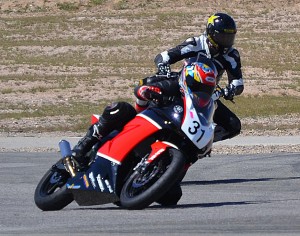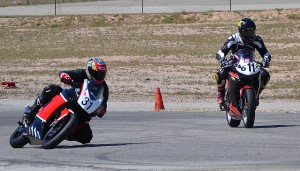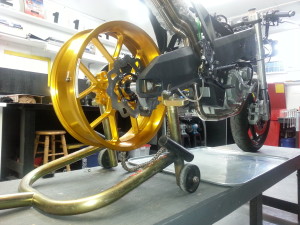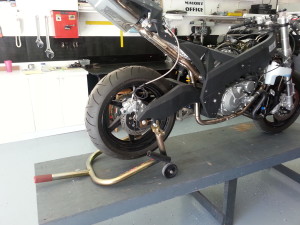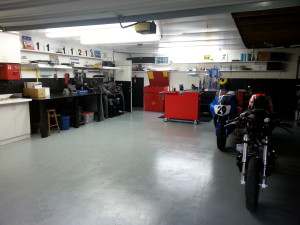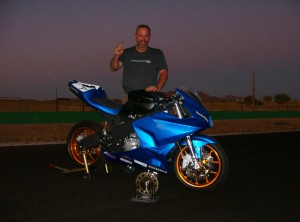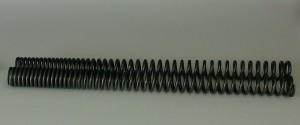Impressed
This just in from Will:
“Hi Ed –
I’ve put 1000mi on the my BMW 1200 GSA’s rear shock you converted for
me. I’m impressed with the improved handling!
I put a post up on ADVRider sharing the excellent experience you
provided.
Thank you again,
Will”
No, Thank you!
The Smart Part
I had a good time this past weekend at Streets. Nine happy clients on Friday with MotoYard and some great racing on Saturday & Sunday with Moto West GP.
Some of you noticed that I do the Bowl and the Skid Pad different than most. I was on the Iceman 250 Ninja. My best lap was 1.31.89 on 3 weekend old Dunlop’s set at 19/19 psi hot.
The wide line I take on the Skid Pad lets me use full throttle much sooner than the tight/common line and it helps me miss most of the bumps. But the real advantage is the speed I can carry onto the Skid Pad because I don’t need to slow down till later.
In this photo I’m pinned in 3rd just below red line while 611X is already braking for the Skid Pad. This is the same line I use on my 600 and every other bike I’ve ridden/raced here.
The question for you is, are you as smart as Stephen Lin? Lin could see that what I was doing worked but at first glance it just looked like I ran wide. The smart part? He asked me what I was doing just like Andrew did the day before.
Andrew saw my lines on Saturday in the endurance race and put them to good use on Sunday setting a new personal best.
If you look up you can see the Sun moving across the sky but that is not what is really happening. Now apply this lesson to your riding.
Photo’s by http://motorbikeroadracing.blogspot.com/
Learning
All I did for Lex was to rebuild his Penske shock. Most of the improvement he is talking about is because he should have had the shock serviced sooner. I’m posting his e mail because he is demonstrating good science, he even points out that he also changed tires when the shock was with me. The suspension adjustments he is planning to try will be min and max compression and rebound. Enjoy your shock Lex and may the learning never end.
Hi Ed:
Sorry it took so long, but my job seems to be getting in the way of my riding time. Didn’t even get a chance to install the shock until a couple weeks ago, and first ride was yesterday. Had an awesome day and rode about 260 miles from Charlotte to the NC mountains and back. This included some interstate, country back roads and mountain twisty’s – so a little of everything. Ride and handling was very nice. Hard to judge the level of improvement since it had been over four months since I last rode the bike, but everything seemed to work better. Interstate was smoother and less harsh over highway joints. Bike felt planted and stable going pretty fast on back roads. And most importantly, handling on curves in the mountains was excellent. I will need more time to dial things in, but for a starting point, the suspension and ride were very good, and accommodated a broad range of road conditions and riding at the initial settings. The one curve where I had noted some wallowing (a long, downhill sweeper with a couple dips in the middle of the curve), was completely different – the suspension just absorbed the slight dips and stayed firmly planted and stable. Transitions from one turn to another seemed more responsive. Of course some of this may be attributable to also having new tires on the bike. I had been running Metzeler Sportec M5’s, but just switched to Dunlop Q3’s, and they seem to be a lot stickier in the curves, and generally more capable. Overall a very satisfying experience, and a really fun day. I look forward to trying some suspension adjustments to see what I can learn. Many thanks for your help and excellent work.
Best regards,
Lex
Cosmos
Today’s “Cosmos” inspired thought:
The next time you learn something new and mind blowing like the bit of evidence we just found supporting Expansion and the Multi-Verse. Don’t think, wow that’s crazy. Think instead, wow what else is can I learn from this.
The Universe works the way it does. It is not for us to limit the Universe by our misunderstandings. Rather, it is for us to learn.
Hi Mom!
Mom says she loves my blog and checks it all the time. This is a test. Let’s see how long it takes her to call me.
PS: 12 hours and 43 minutes. This blog is followed and approved by my Mom.
Wave Caliper
New Shop Floor!
New Shipping Address
Our shipping address is:
Lindemann Engineering
700 East Redlands Blvd. Ste U Box 410
Redlands, CA 92373
Only the shipping has changed.
Digressive Springs!
Lindemann Engineering is pleased to announce a major breakthrough in suspension technology – the world’s first Digressive springs. Through an ingenious combination of metallurgy, manufacturing process and particle physics,
Lindemann Engineering’s Ed Sorbo has found the Holy Grail of suspension technology.
Progressive and straight-rate springs are well known in the suspension world. But a digressive rate spring has long been sought for the ability to let the suspension move just as fast at the end of the travel as it can at the beginning.
The breakthrough came when Sorbo was doing a thought experiment. Says Sorbo, “The problem with making a digressive spring is getting the metal to act in two different ways. I was pondering light’s ability to behave as a wave and as a particle. Then I remembered something Jim Lindemann said to me, and that was the eureka moment!”
Sorbo says his recycle bin has some very expensive scrap metal in it after some spectacular failures. But three years of hard work has paid off. The first test was a complete success with Bill Wickersham riding the test bike, a Fisher MRX appropriately named Particle to a win in it’s first-ever race. The long delay since that win, which proved the value of digressive springs, was caused by the development of a manufacturing process. Sorbo made the first springs by hand. Says Sorbo, “Never again!”
Particle’s sister, Wave, is being built right now with the first set of production LE Digressive Rate Springs. Sorbo says the potential uses for his springs are limitless, “I think we will see a set on the next Mars rover. In fact, if NASA asks I’ll sponsor them a set. Heck, I’ll even give them a lifetime warranty. I wonder what April 1st is like on Mars.”
Photo Caption: Bill Wickersham at Willow Springs with LE Digressive Rate Springs equipped Fischer MRX “Particle” and his First place California State Championship trophy in the bike’s first-ever race.
The work of the Devil
These are progressively wound springs. The part where the wire is close together is weak while the part with the wire loops farther apart it stronger.
Yes, I want you to think of springs as stronger or weaker not softer or harder because their job is to hold things up not for you to rest your head upon.
A progressively wound spring starts out weak and gets stronger as you compress it. A straight rate spring gets stronger at the same rate as you compress it. A straight spring with a rate of 100 lbs will compress one inch when you place 100 lbs on it, two inches with 200 lbs and so on. A similar progressive spring will start with a rate of 75 lbs, when that’s used up the stronger rate of 150 lbs takes over.
This sounds nice and comfortable and it is if you are sitting on a coach. But you are riding a motorcycle with suspension that moves fast near the top of it’s travel and slow near the bottom. You want to spend most of your time near the top so the wheels can get out of the way of the bumps. A spring that gives up the best part of the travel as soon as you sit on the bike is not what we want.
What happens when you ride over a bump near the bottom of your travel. The suspension can’t move up fast enough so that end of the bike has to move side to side to make up for the extra distance it has to travel over the bump compared to the other wheel. This is what causes that “cheap wallow” in turns.
So unless you have a fiddle and play it well keep away from the Devil and his agent of despair the progressively wound spring.

